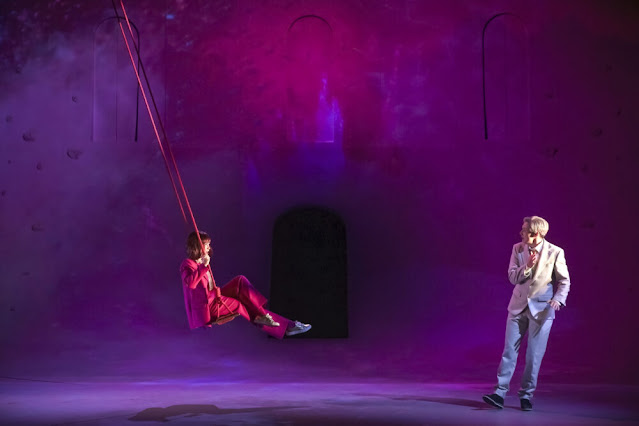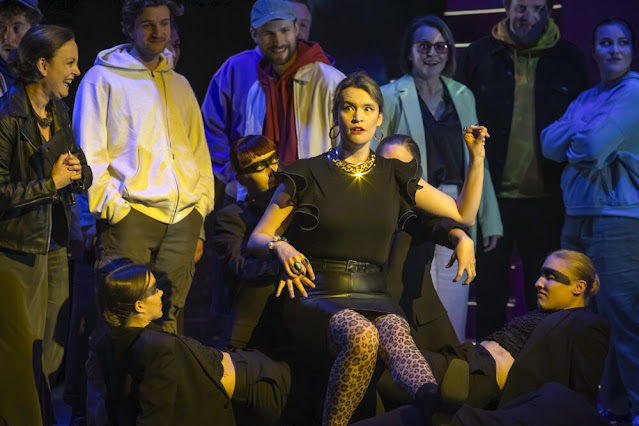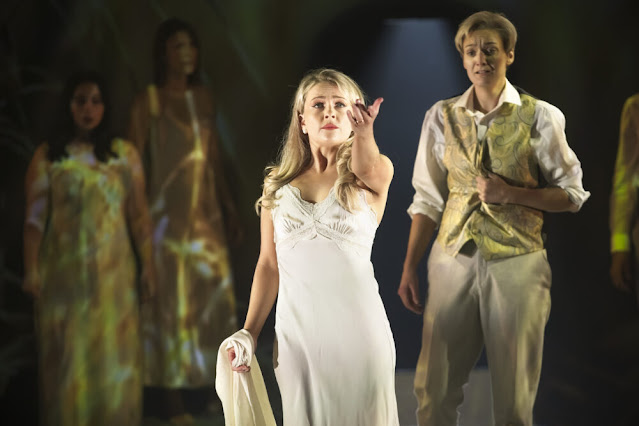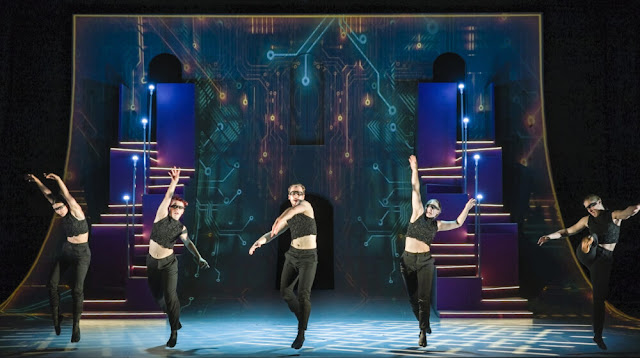 |
| Gluck: Orfeo ed Euridice - Caroline Blair, Heather Lowe - The Grange Festival (Photo: Craig Fuller) |
Gluck: Orfeo ed Euridice (Vienna version), Purcell: Dido and Aeneas; Heather Lowe, Alexandra Oomens, Caroline Blair, James Newby, Helen Charlston, director: Daniel Slater, The Sixteen, conductor: Harry Christophers; The Grange Festival
22 June 2023
Having collaborated with director Daniel Slater on The Grange Festival's production of Handel's Belshazzar in 2019 [see my review], Harry Christophers and The Sixteen returned to The Grange for Slater's intriguing double bill of Gluck's Orfeo ed Euridice (in the original 1762 Vienna version) and Purcell's Dido and Aeneas. We caught the performance on 22 June 2023. Three roles were doubled, Heather Lowe was Orfeo and Dido with Alexandra Oomens as Euridice and Belinda, Caroline Blair as Amor and the Second Woman, plus James Newby as Aeneas, Helen Charlston as the Sorceress. The Grange Festival Chorus was joined by The Sixteen, with the Orchestra of the Sixteen in the pit. Designs for both operas were by Robert Innes Hopkins with choreography by Tim Claydon, lighting by Johanna Town and video by Nina Dunn for PixelLux.
The operas provide two classic arias of lament, whilst each takes a somewhat different musical approach to the sufferings of humankind at the hands of capricious gods. Both are also short, yet difficult to programme; neither was intended as a full evening in the theatre, both being entertainments - Orfeo ed Euridice was part of a wedding celebration, whilst Dido and Aeneas was probably intended as court entertainment for King Charles II.
 |
| Purcell: Dido and Aeneas - Helen Charlston - The Grange Festival (Photo: Craig Fuller) |
Another link between them, albeit one not particularly helpful for directors, is that both have a complex textual history. Orfeo ed Euridice exists in three distinct versions, the original for alto castrato performed in Venice, a revised version for soprano castrato which was shortened with simplified orchestration for a triple bill in Parma and the revised, expanded version to a new French libretto created for Paris with a high tenor in the title role. Berlioz then created a further version which synthesises the Paris and Vienna versions using a solo mezzo-soprano.
Dido and Aeneas survives with no manuscripts from Purcell's time, all we have are later ones. The music for the prologue does not survive at all. The earliest known performance and libretto relate to a production at a school for young ladies in Chelsea. Though an earlier court production seems likely, which suggests the original might have been raunchier and more comic.
At The Grange, Robert Innes Hopkins provided a single set, a striking sloped surface with openings, onto which Nina Dunn's videos were played. This created some strikingly effective settings and enabled a remarkable change in quality between the two operas.
 |
| Gluck: Orfeo ed Euridice - Alexandra Oomens, Heather Lowe - The Grange Festival (Photo: Craig Fuller) |
Orfeo ed Euridice, set in the modern day, moved from pastoral idyll to gloomy ruins to more idealised nature images for the Elysian Fields and finally a labyrinth, all with judicious use of abstraction in the transitions. The shape of the set, with its curve downwards, proved essential as lost souls attempted and failed to escape Tartarus in Act Two, scene Two, the dancers repeatedly sliding down the slope. Then, most memorably, at the end of Act Three, on Euridice's return to Hades, Alexandra Oomens slid down the slope. The images were large scale, striking and surprisingly apposite.
For Dido and Aeneas, also in a modern setting in a world full of glossy images and 'influencers', the images consisted of a sequence of pseudo-magazine covers, wittily charting the affair between Dido and Aeneas. A pair of striking staircases provided space for the chorus in static moments.
The chorus consisted of ten members of The Sixteen alongside eight members of the Grange Festival Chorus, plus five dancers. Both works feature a strong dance element and here, though there were five dancers, much of the heavy lifting was done by the chorus. This gave an amiably haphazard element to the ensemble dances with some 23 people moving around the small Grange stage. In both operas Daniel Slater told the story with admirable clarity, the modern settings bringing out details rather than compromising them. He also provided scope for strong solo performances, these stagings knew when it was important for nothing to happen.
 |
| Purcell: Dido & Aeneas - The Grange Festival (Photo: Craig Fuller) |
Heather Lowe made a striking, very boyish Orfeo, convincingly eager during the wedding and then going on a powerful journey. Lowe's relatively light mezzo-soprano gave the character a youthful fluidity (there were hints that at Baroque pitch the role might low for her). Gluck's music is not so much about arias, but about fluid arioso, something Lowe did superbly. Her Lament in Act Three was moving indeed. Alexandra Oomens was a vivid Euridice, very much a live-wire, her scene with Lowe's Orfeo in Act Three was vividly done, with Oomens and Lowe's interaction unfolding in a way that was engrossing even though we knew where things were headed. Caroline Blair made a pert Amor, entering on a swing (a witty reference to Cupid's flying), wearing a hot pink trouser suit.
There was a youthful lightness to the story-telling, undoubtedly moving yet without the element of high tragedy that grand dames of the past brought to the opera (I saw Dame Janet Baker twice as Orfeo). Slater included some of the dances at the end, perhaps still too many for my taste, but he used them to retell the story and leave us in seeming limbo, Lowe's Orfeo, still separated from Oomen's Euridice.
Dido and Aeneas had a strikingly different feel. Purcell's opera alternates broad comedy and high tragedy. Here the comedy was smoothed over and replaced by a striking sense of wit. The way the modern magazine culture and social media provided an alternate commentary on the story, and someone had had great fun at inventing apposite headlines. Dido and Aeneas were both modern heads of state, counterparts of the mythic characters, we even saw film footage of the Greeks' invasion of Troy. The two pink/purple staircases provided striking perches for a chorus that acted as commentator and witness rather than participant.
 |
| Purcell: Dido & Aeneas - Heather Lowe, James Newby - The Grange Festival (Photo: Craig Fuller) |
Heather Lowe, looking very different from her Orfeo, was an intense, febrile Dido, an interpretation that made the character strikingly modern yet brought out the tragedy and her account of her final Lament was daringly intimate and remarkably moving. Daniel Slater kept the chorus off stage for the preceding chorus so that for the Lament, it was just Lowe and Oomens on stage. Oomens made an active, vividly drawn Belinda. A modern influencer who unintentionally stokes the tragedy and Oomens brought out the regret and moving tragedy at the end. Aeneas is an underwritten role, no aria and just a few lines of dialogue. But James Newby made him visibly impressive and sang the arioso with great style, making his contribution remarkably telling.
The witches were portrayed as a modern alternative group, wit and style rather than broad comedy. Helen Charlston's performance as the Sorceress was truly remarkable. Without a silly voice in sight and looking a million dollars in leather dress and heels, she commanded the stage from her first entrance - this was pure Cruella de Vil with an added sense of glee. Kirsty Hopkins and Katy Hill made gleeful, hyperactive witches, eager minions for Charlston's Sorceress to command. Charlston played the Spirit too, the Sorceress in disguise rather than a pseudo-mythic figure.
George Pooley, normally seen sedately singing in the Sixteen, proved engagingly adept at a soft shoe shuffle in his amusing dance routine as the Sailor. Again, no funny accents and wit replacing broad comedy. Caroline Blair was the very supportive second woman.
The chorus in both operas was wonderfully hard working, very much all-singing, all-dancing, they combined fine, lithe singing with enthusiastic with-a-will dancing. This wasn't formal court dancing, but more lively social dancing from the very middle-class wedding in Orfeo to writhing furies in Orfeo's Act Two. The five dancers did everything from vivid dance interludes to carrying Euridice's corpse off stage to a backing group for Amor to sliding down the sloped set.
 |
| Gluck: Orfeo ed Euridice - Heather Lowe (Orfeo) and the Furies - The Grange Festival (Photo: Craig Fuller) |
Harry Christophers' speeds were moderate, apposite, these weren't performances of extremes and he is sensitive accompanist. The orchestra was in fine form and this was an evening full of strong colours. Gluck's score includes chalumeau, harp and cornett and they used both organ and harpsichord. This sense of instrumental colour carried over into the Purcell.
This was an engaging and ultimately touching evening. In both operas, witty modernisation was allowed to make space for some moving performances. The Grange Festival's theatre is ideal for operas of this size, providing intimacy and grandeur without the performances having to bee over-inflated to fit a larger building. Next year, the festival is presenting Monteverdi's L'incoronazione di Poppea.
Never miss out on future posts by following us
The blog is free, but I'd be delighted if you were to show your appreciation by buying me a coffee.
Elsewhere on this blog
- Visually seductive and strikingly arresting: The Queen of Spades at The Grange Festival is a real study in obsession - opera review
- Adding the countertenor voice to the conversation: Iestyn Morris on recording a disc of romantic Russian song - interview
- One of the towering masterpieces of the chamber music repertoire: violinist Simon Blendis introduces Enescu's Octet - guest article
- Stylish performances all round: a winning account of Mozart's Cosi fan tutte at The Grange Festival that engages as well as questions - opera review
- Rückert lieder: Ian Bostridge and Julius Drake in songs by Robert & Clara Schumann, Schubert, Henze and Mahler - concert review
- We simply forget that there was anything young artist about the evening: Hansel & Gretel at Opera Holland Park - opera review
- Colour, text & character: Dresden Music Festival launches its historically informed Ring cycle -with gripping Das Rheingold - opera review
- A little bit of magic: Asya Fateyeva and Lautten Compagney Berlin at the Dresden Music Festival - concert review
- Mozart's late masterpiece: La Clemenza di Tito from Chelsea Opera Group with Helena Dix and Kezia Bienek - opera review
- Verdi's Rigoletto: Opera Holland Park's opening production for 2023 with Elgan Llyr Thomas as the Duke - opera review
- Simplicity is one of the hardest things to do: composer Debbie Wiseman on the challenges of writing music and introducing her new disc, Signature - interview
- Home




%20TallWall%20Media_Oxford%20Song.jpg)
%20TallWall%20Media_Oxford%20Song.jpg)
%20TallWall%20Media_Oxford%20Song.jpg)




No comments:
Post a Comment